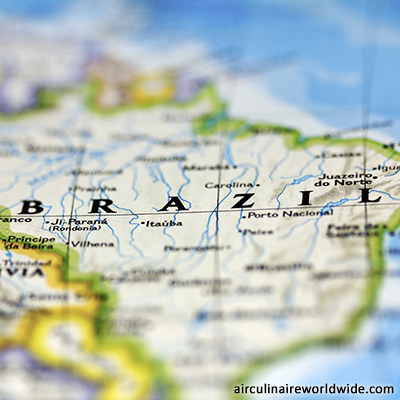With the 2014 World Cup fast approaching and involving so many cities in Brazil, it is best to familiarize oneself with the types of cuisine that can be expected in each region. While certain Brazilian dishes are available throughout the vast country, each region has unique culinary creations that showcase its local flair. Learn what each region has to offer, so you can navigate Brazilian cuisine like a pro.
Northern Brazil
If you are operating to northern Brazil, you will notice that the local cuisine is heavily influenced by the indigenous people of the Amazon. For example, “pato no tucupi,” a dish of wild duck with fermented cassava juice, is a common dish in this area. Cassava juice is sometimes substituted with vinegar since vinegar offers acidity similar to that of cassava but removes the risk of poisoning associated with improper cassava preparation.
Southern Brazil
Churrasco-style meats are extremely popular in this area of the country, so you will not want to miss the opportunity to try them. Due to strong European influence, you’ll also find cabbage, potatoes, pasta, and European-style coffee in this area. “Arroz de Paretero” is a tasty risotto dish made with rice, fried meat, garlic, and onions sauteed with “charqui,” a type of dried and salted beef reminiscent of jerky. For a more unique, local beverage, try “chimarrao” (similar to Argentina’s “yerba mate” and recently in the global spotlight as a favorite of Pope Francis, who is from Argentina.) Keep in mind though, that specific vessels should be used when drinking chimarrao, and that water temperature and steeping time need to be exact to keep the beverage from becoming bitter. Sushi is also a favorite in southern Brazil, especially in Sao Paulo, where there is a large community of citizens who are of Asian descent.
Western Brazil
Vegetables are the centerpiece of cuisine in western Brazil. Here, you will find a wide selection of gourds, squash, and corn, as well as an assortment of legumes. Additionally, a variety of seafood is readily available and is a staple in the local diet. Another point of note is that many ingredients are stewed in “dende” (palm) oil. This oil has a signature reddish color and is often used in rice dishes. Health-conscious passengers should seek an alternative to dende oil since it is high in saturated fat. Likewise, anyone with a nut allergy should ask for another oil to be used in catering.
Eastern Brazil
Overall, this region of Brazil is marked by the popularity of fish and seafood, while the northeast has a strong African culinary influence. “Bobo de camarao” is a West African-influenced meal that consists of cassava, shrimp, coconut milk, and dende oil. Another unique local dish, BBQ “pacu” ribs, is made from the meat of the “pacu,” a large freshwater fish related to the infamous “piranha.” Interestingly, the texture of a pacu’s meat is much more like that of veal than that of a typical fish.
National Brazilian Cuisine
Plantains, coconuts, Acai berries, and sugar cane are all used in a variety of Brazilian culinary creations. Tapioca and guarana seeds, which are high in caffeine, are used to make the national soda, “Guarana Antarctic.” Black beans, black-eyed peas, and “jambu” (similar to collard greens) are all popular vegetables. Rice is used throughout the country but is typically replaced by pasta and potatoes the farther south you travel. Since winter hits in the middle of the year, “vaca atolada,” a casserole-style dish featuring beef ribs and cassava root, will be popular if you are visiting during the colder months.
Brazil has a mouthwatering cheese bun called “pao de queijo,” which is made with a specific type of Brazilian cream cheese. If you enjoy falafel, try “acaraje,” a flavorful feast of ginger, black-eyed peas, and dried shrimp that is deep fried in dende oil. “Empanadas” are a more widely known South American specialty that can be sweet or savory, depending on the ingredients. Guava, cheese, and shrimp are all commonly used as empanada fillings.
After exploring the variety of flavors Brazil has to offer, make sure to save room for dessert. Yes, traditional Brazilian cuisine is known for its range of tempting desserts. If you are looking for indulgence, try “brigadeiro,” a chocolate bonbon with powdered chocolate and condensed milk and rolled in chocolate sprinkles. Another uniquely Brazilian dessert is “Romeo e Julieta,” a traditional mixture of guapa paste and minas cheese which is used in various treats such as “bolos” (cakes), empanadas, and even ice cream.
Brazilian flavors are quite remarkable and have been gaining popularity worldwide. No matter where you’re traveling next, consider adding a Brazilian flair to your next in-flight dining experience. To make meals truly memorable while operating in Brazil, work with your in-flight caterer to source uniquely appealing cuisine choices from a variety of regions of the country.
Questions?
If you have any questions about inflight catering in Brazil, contact weborders@airculinaire.com.






